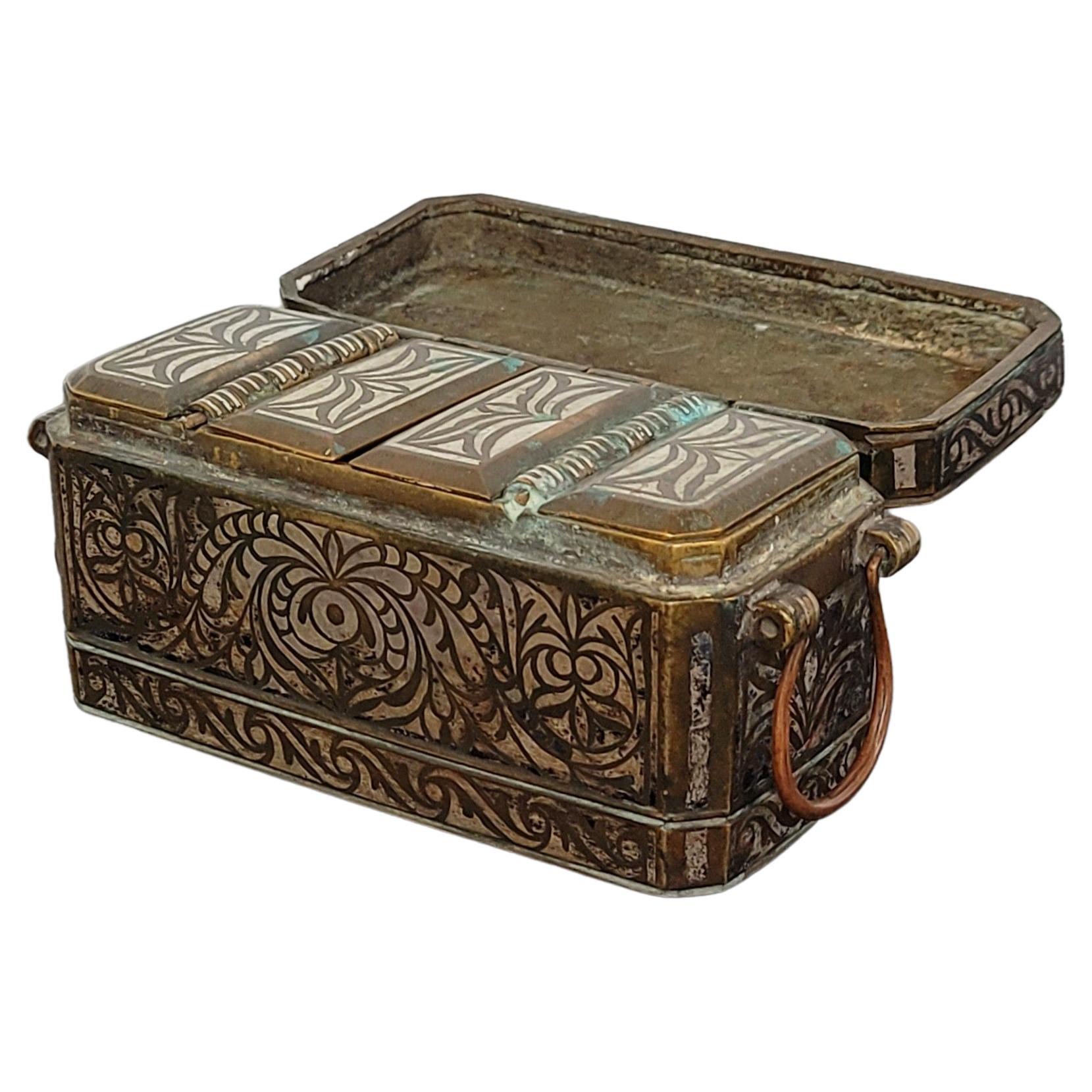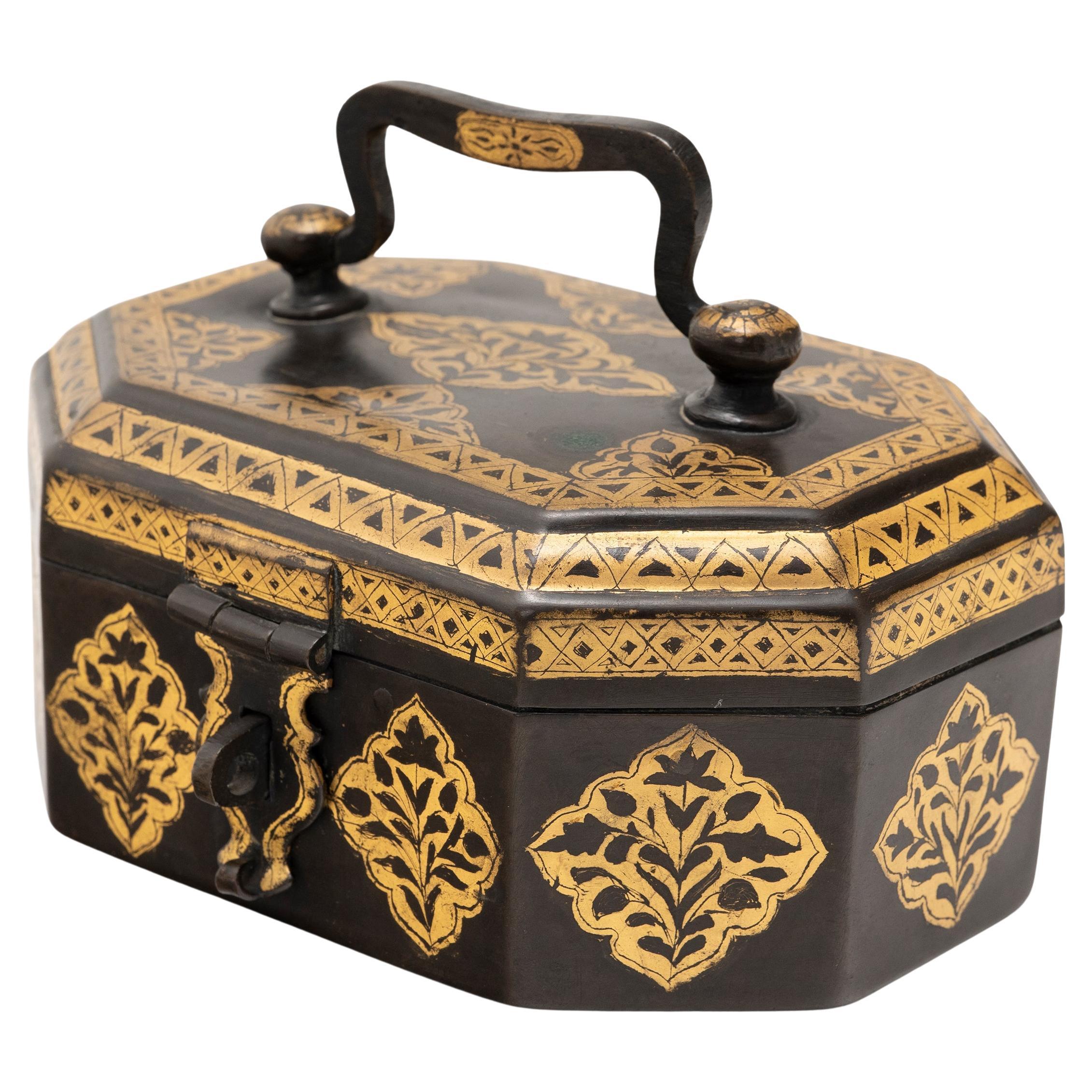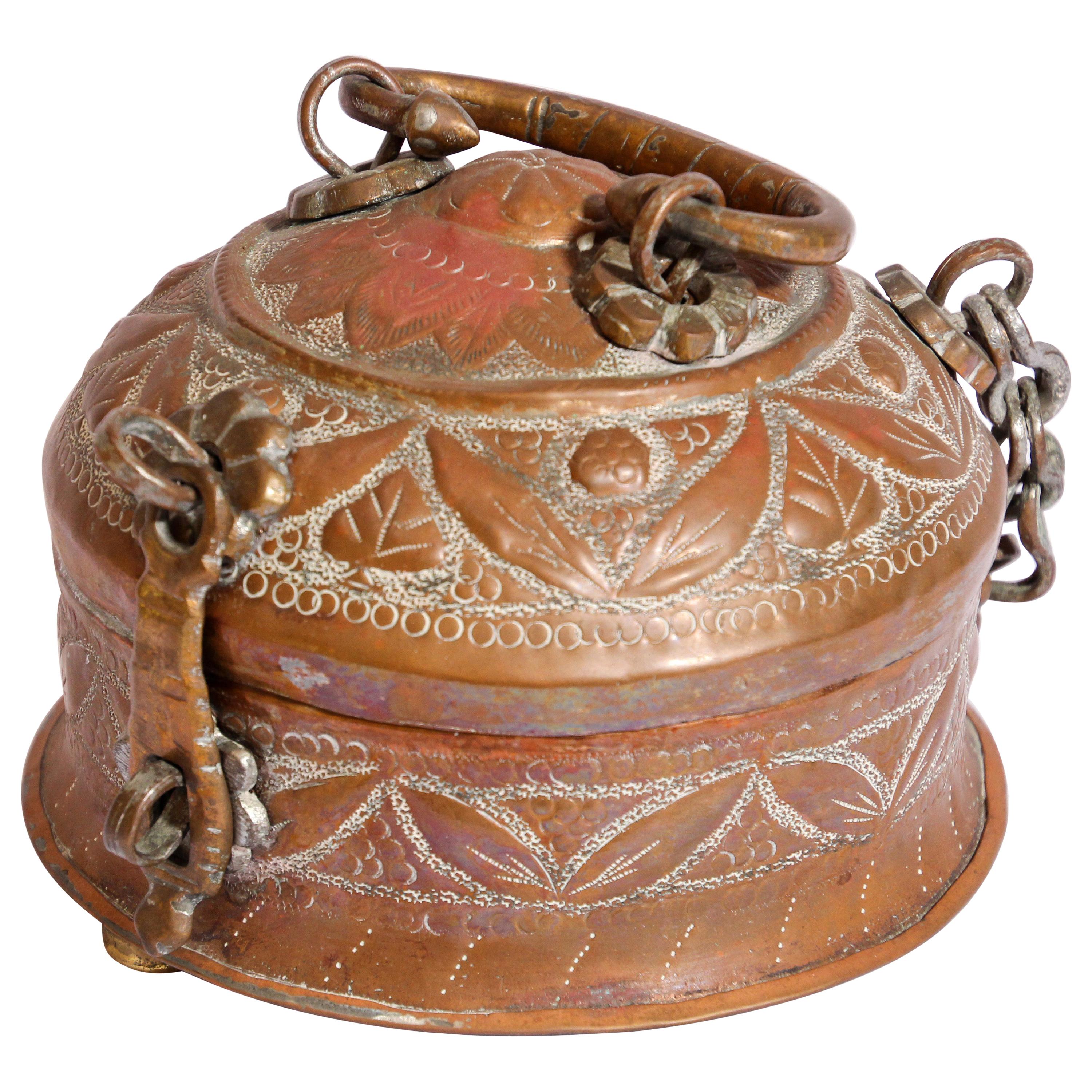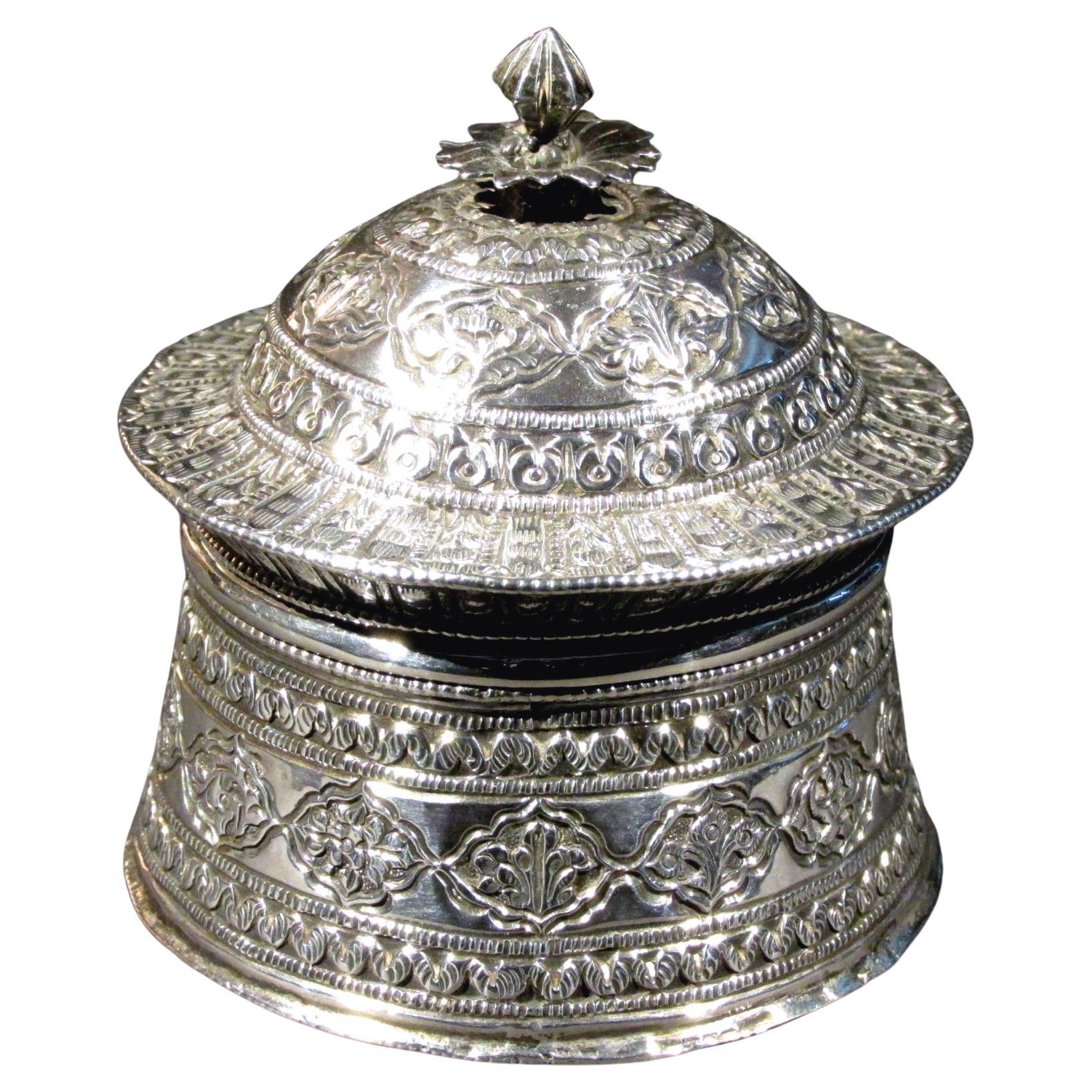Items Similar to Set of 6 Mindanao Brass Silver Betel Boxes, Philippines
Want more images or videos?
Request additional images or videos from the seller
1 of 21
Set of 6 Mindanao Brass Silver Betel Boxes, Philippines
About the Item
Presenting an amazing set of 6 Mindanao brass silver betel boxes, Philippines.
Betel chewing was prevalent in the southern Philippines as in much of the rest of Southeast Asia. Wealthier Maranao families on Mindanao were able to afford elaborate silver-inlaid brass betel boxes such as these examples, made up of 3 large and 2 medium boxes made of brass and silver and one smaller one made of silver and copper.
Such boxes were used to show off to household visitors and from which they were offered betel and the other component such as leaves and lime to make up the betel quid.
The box comprises an outer box with a hinged lid and handles, and an inner box that is divided into three lidded compartments covered by four hinged lids. One compartment was for powdered lime which was an essential part of the betel quid. Remnants of lime remain caked to the interior.
Both the inner and outer boxes rest on coin-like ‘wheels’. The inner box is a separately made, self-contained unit decorated on all sides with silver inlay. It drops into the outer box.
Both the outer and outer boxes are decorated with silver inlay on all visible sides with a repeated stylised orchid motif within scrolling obid-obid (stylised rope) borders, and stylised tail feathers of the sari-manok bird. Designs such as these are drawn from a local design repertoire that has its origins in wood carving.
This lutuan represents a fine and large example of Islamic metalwork from the most eastern outreach of Islamic art and civilisation: Mindanao island being significantly further east than even China – artwork from Islamic Southeast Asia remains chronically under-represented in the world’s major collections of Islamic art. It is in excellent condition with no losses to the silverwork. Evidence of use remains inside the lidded chambers.
Smaller examples are illustrated in several books including Henkel et al (2009, p. 156). Lutuan tell an interesting story of the spread of Islam and Islamic crafts. The silver inlay work shown on this box originated in Syria. The function originated in India. But the craftsmen were based in the Islamic southern Philippines.
These examples are in fair to good original condition with a fine patina suggesting their age. There are some minor repairs and losses to the silverwork. All are missing their handles. Some internal lids are missing as can be seen from photos.
The larger one has lost its wheels on the left due to loss of the brass undercarriage that would have held the wheels. The right side actually has Philippine US Silver coins dated 1944 and a copper cap. These would have been added to the box in 1944 as the box would have been made circa 1890-1900.
This is a rare chance to own an immediate collection of these rare boxes !
Provenance: From a Private Dallas Collection
Condition: Fair to good original condition. Some losses and repairs as listed in the description and evident from photos.
Dimensions: Large box on wheels is 5 inches tall, 8 inches wide and 3.75 deep
Large box on left is 4 inches tall, 8 inches wide and 3.75 deep
Large box on right is 4 inches tall, 7.5 inches wide and 3.5 deep
Medium box on left is 3.25 inches tall, 6.75 inches wide and 3.2 deep
Medium box on right is 3.25 inches tall, 6.75 inches wide and 3.2 deep
Small box at the front is 2.75 inches tall, 6 inches wide and 3 deep.
- Dimensions:Height: 5 in (12.7 cm)Width: 8 in (20.32 cm)Depth: 3.75 in (9.53 cm)
- Sold As:Set of 6
- Style:Islamic (Of the Period)
- Materials and Techniques:
- Place of Origin:Philippines
- Period:
- Date of Manufacture:1890
- Condition:Replacements made: Wheels on larger one. Repaired: Some hinges repaired. Wear consistent with age and use. Minor losses. Minor structural damages. Minor fading. In fair to good original condition with a fine patina suggesting their age. There are some minor repairs and losses to the silverwork. All are missing their handles. Some internal lids are missing as can be seen from photos.
- Seller Location:Dallas, TX
- Reference Number:1stDibs: LU3978127583752
About the Seller
4.9
Gold Seller
These expertly vetted sellers are highly rated and consistently exceed customer expectations.
Established in 2015
1stDibs seller since 2018
349 sales on 1stDibs
Typical response time: <1 hour
- ShippingRetrieving quote...Ships From: Dallas, TX
- Return PolicyA return for this item may be initiated within 7 days of delivery.
More From This SellerView All
- 19C Anglo Ceylonese Sewing Box of Museum QualityLocated in Dallas, TXPresenting an absolutely stunning 19c Anglo Ceylonese sewing box of museum quality. Made in Ceylon (now Sri Lanka) circa 1860, this is one of the finest sewing boxes of it’s kind that we have ever seen! The box is made from coromandel wood (an exotic hardwood found in Ceylon) and has a serpentine edging all over the front, back and sides. Very often the lids/tops of these boxes suffer cracks due to shrinkage but this one is near perfect with no crack in the lid/top. There is some evidence of natural shrinkage but that is around the edges of the lid/top. It is when you open this box that it reveals it’s true beauty, quality and treasure ! The inside of the lid/top is heavily and beautifully decorated with inlaid bone in scrolling floral patterns which have then been hand painted with red and black ‘lac’ ink. The central medallion is a circle of inlaid specimen exotic hardwoods radiating towards a central bone and hand painted flower. The circle is edged in bone, wood and silver chevrons. What makes this box Exceptionally rare is that it contains 3 lift out base sections. Normally, there would be a maximum of 2. The first tray/section is clearly for the purposes ancillary to sewing with a pair of sections with bone spools for thread etc. There are 17 other lidded compartments with each one highly decorated using hand painted bone and specimen woods to replicate tortoiseshell. The first tray lifts out to reveal a second removeable tray which is made up of a pair of open sections and 8 specimen wood lidded sections each with chevron banding. The third tray is a smaller tray underneath with 14 lidded compartments each with hand painted bone and specimen wood inlaid lids again, replicating the look of tortoiseshell. Again they are banded with a chevron border. This is a museum quality piece ! It is in fantastic condition for it’s age with the minor shrinkage to the edges of the lid/top, some finger pulls missing and some very minor cracks to the tray lids and bases but nothing that in any way detracts from the piece. No key. Dimensions: Closed the box is 16.75 inches wide, 11.25 inches deep and 7.5 inches high Fully open the box is 16.5 inches high, 16.75 inches wide and 11.4 inches deep Anglo-Indian and ceylonese boxes: Anglo Indian boxes were made in India for the English residents from the early part of the 18th century. They were brought back or sent back to England usually by the people who had commissioned them. From the beginning of the nineteenth century they were imported more commercially, although not in any significant numbers until the middle decades. They were very highly valued, especially the early ones, to the extent that the designs were copied on late 19th and early 20th century tins. Anglo-Indian boxes normally consist of 3 main types:- (1) Most of the best and highest quality Anglo-Indian boxes in the 18th and 19th centuries were made in Vizagapatam, India, renowned for its exquisite craftsmanship in using ivory and tortoiseshell and lac decoration. These are referred to as ‘Vizagapatam Boxes...Category
Antique Mid-19th Century Sri Lankan Anglo-Indian Decorative Boxes
MaterialsSilver
- 19th Century Italian Ruby Glass Box with Miniature of BasilicaLocated in Dallas, TXLovely little 19th century ring jar or pill box made of a thick wine colored ruby glass. It has a miniature of a Basilica on top, gilt metal mounts with beautiful filigree on the si...Category
Antique Early 19th Century Vatican Grand Tour Decorative Boxes
MaterialsMetal
- Vintage Japanese Temple Style BoxLocated in Dallas, TXPresenting a lovely vintage Japanese Temple style box. Made of rosewood … this box has a cover featuring Buddhist Swaztikas on the front. The cover lifts off to reveal a tabernacle with 2 carved dragons on wither side. Probably made in the first quarter of the 20th century, circa 1920-1930. Rectangular shaped for the storage of deities statues...Category
Early 20th Century Japanese Japonisme Decorative Boxes
MaterialsWood
- 19C Anglo Indian Highly Carved Padouk Sadeli Mosaic Scroll Box of Hindu GodsLocated in Dallas, TXPRESENTING AN ABSOLUTELY STUNNING AND EXCEPTIONAL 19C Anglo Indian Highly Carved Padouk Sadeli Mosaic Scroll Box of Hindu Gods from circa 1870-80. The box case is made from sandalwood with highly hand-carved padouk wood reliefs on all sides and banded and edged in fabulous ‘Sadeli Mosaic’, made from faux ivory/bone, ebony, silver, semi-precious green stone, etc., in various geometric patterns. The carved lid of this box is EXCEPTIONAL! It is HIGHLY HAND-CARVED and depicts 13 Hindu Gods: Vishnu, Shiva, Harihara, etc., in 9 oval shaped reliefs, surrounded by foliage etc. The sides and rear have highly carved foliage relief panels. The lid opens to reveal the original red velvet lining (also on the base) in SUPERB CONDITION throughout. The QUALITY of the ‘sadeli mosaic’ work is EXCEPTIONAL all over. It has its key and working lock. It sits on it’s 4 original brass turned ball feet. THIS IS A HIGH QUALITY & VERY RARE AND DESIRABLE BOX! SADELI MOSAIC: “Anglo Indian boxes were made in India for the English residents from the early part of the 18th century. They were brought back or sent back to England usually by the people who had commissioned them. From the beginning of the nineteenth century they were imported more commercially, although not in any significant numbers until the middle decades. They were very highly valued, especially the early ones, to the extent that the designs were copied on late 19th and early 20th century tins. The ancient art of Sadeli Mosaic is said to have been introduced from Shiraz in Persia via Sind to Bombay, a long time before the Anglo Indian boxes were made. It was a technique, which required a high degree of skill and patience. It was executed very lavishly, in that the frequent cuts wasted a great amount of the precious materials used. The workmanship was however more than commensurable to the value of the materials. Ivory, silver, pewter (or other metals), wood and horn were cut into faceted rods which were bound together to form geometric patterns. When the glue has set, the rods were sliced in transverse sections. This gave the maker a number of angled circular pieces in the original pattern. Several variations of patterns could be achieved by combining the materials in different ways. The ivory was sometimes dyed green to give an extra color. The mosaic pieces in a combination of patterns, often separated by ivory, ebony, horn or silver stringing were used to veneer sandalwood boxes. In the early boxes, which date from the turn of the 18th to the 19th century, there are large panels of mosaic covering tops and sides of boxes. It took incredible skill to cover such large areas without any shakes or wavering of the pattern. The corners and joins on these boxes are impeccably matched. The makers (reputed to be Persian) of Sadeli mosaic made in the first two decades of the 19th century displayed a total understanding of the qualities of the different materials they used. They combined substances, which can expand and contract according to atmospheric conditions with others, which are hard and unyielding. The result was a sharp definition of the lines and patterns, which made up the whole design. On the early boxes the designs look deceptively simple. The fact is, they emerged from a culture, which had mastered geometry and understood how to generate a pattern from a set number of points. The patterns are so harmoniously combined that their incredible complexity is not immediately apparent. The earliest Sadeli boxes...Category
Antique 19th Century Indian Anglo-Indian Decorative Boxes
MaterialsSilver
- Vintage Limoges Purse Shaped BoxBy LimogesLocated in Dallas, TXPresenting a lovely and exceptionally cute vintage Limoges purse shaped box. Made in Limoges, France circa 1900-20. Marked on interior as “Limoge...Category
Early 20th Century French Beaux Arts Decorative Boxes
MaterialsOrmolu
- 18th Century French Louis XVI Ring Box with Miniature Portrait of LadyLocated in Dallas, TXPRESENTING A STUNNING little French Ring Box from the 18th Century, namely a French Louis XVI Brass and MOP Box with Miniature Portrait of Lady. Box inlaid wi...Category
Antique Late 18th Century French Louis XVI Jewelry Boxes
MaterialsBrass
You May Also Like
- Antique Southeast Asian Filipino Maranao Silver Inlaid Brass Betel Nut BoxLocated in Forney, TXA scarce fine quality antique silver-inlaid solid brass betel nut box (Lutuan), dating to the second half of the 19th / early 20th century, hand-crafted in Mindanao, Philippines. Boxes such as this were used to store the areca nut (also known as the betel nut) which would be wrapped in a betel leaf with lime paste and other ingredients, often tobacco, for chewing. Similar to the European tea caddy, these boxes often served as a way to impress while showing off ones wealth. Betel chewing was prevalent in the southern Philippines as in much of the rest of Southeast Asia. Wealthier Maranao families on Mindanao were able to afford elaborate silver-inlaid brass betel boxes such as this example. Such boxes were used to show off to guests and from which they were offered betel and the other component such as leaves and lime to make up the betel quid. Rare large size, most extant examples of such boxes tend to measure around 5 inches in length. At slightly more than 7.75 inches the example here is larger than most. The distinctive decorative box features a very heavy strong-box like rectangular shaped chest form with canted corners, copper handles, and a conforming hinged lid, lifting open to reveal an interior divided into three compartments covered by four hinged lids. Each of these doors is inlaid with silver in stylized orchid flower patterns. Exceptionally executed throughout, the arabesque silver inlaid exterior is decorated to the top with a large orchid motif within scrolling obid-obid (stylized rope) borders. The front, back and sides are inlaid with sets of stylized tail feathers of the sari-manok bird beneath which are unusual, highly stylized whimsical zoomorphic faces that appear like cat or tiger faces. (Such stylisation is accounted for by Southeast Asian Islamic preferences to avoid the overt and this potentially idolatrous representation of animal and human forms. Designs such as these are drawn from a local design repertoire that has its origins in wood carving. Although the spread of Islam in the Philippines began in the 14th century, mostly through the influence of Muslim merchants from the western Malay Archipelago, decorative arts in this design remain exceptionally rare. This lutuan represents a fine example of Islamic metalwork from the most eastern outreach of Islamic art and civilisation: Mindanao island being significantly further east than even China – artwork from Islamic Southeast Asia remains chronically under-represented in the world’s major collections of Islamic art. PROVENANCE / ACQUISITION Acquired from highly reputable auction house, Austin Auction Gallery, established 1983, Austin, Texas. References Brownrigg, H., Betel Cutters...Category
Antique 19th Century Philippine Islamic Decorative Boxes
MaterialsSilver, Brass, Bronze, Copper
- Antique Philippines Silver Inlay Betel Nut BoxLocated in Montreal, QCThis is a fine example of an early 20th C rectangular bronze betal nut box with beautiful and elaborate silver inlay from Mindanao in the Philippines. The box has a handle on each si...Category
Antique Early 1900s Philippine Decorative Boxes
MaterialsSilver
- Indian Brass Betel Nut Box, c. 1900Located in Chicago, ILThis ornate Indian betel nut box dates back to the early 20th century. Known in India as a paan daan, this box was used in the ritual of chewing betel nut or paan, a practice that da...Category
Early 20th Century Indian Folk Art Decorative Boxes
MaterialsBrass, Copper
- Antique Brass and Copper Betel Nut BoxLocated in Chapel Hill, NCAntique Philippine Brass and Copper Betel Nut Box. The top lifts to reveal 2 hinged compartments that held the betel leaf and areca nut. Inlaid in c...Category
Antique Late 19th Century Philippine Tribal Decorative Boxes
MaterialsBrass, Copper
- Rajasthani Decorative Brass Lidded Betel Caddy BoxLocated in North Hollywood, CAHandcrafted decorative round brass Indian lidded betel box with latch and a top handle. Delicately and intricately hand-chased with geometric designs. Used as a tea caddy with tea bo...Category
Antique Late 19th Century Indian Agra Metalwork
MaterialsBrass, Copper
- Unique & Stunning 1800s Bronze & Brass Betel Nut Box Museum Quality & ConditionLocated in Lisse, NLTop quality, good size and excellent condition antique box for the connoisseurs. How do you price a one of a kind antique of a quality and beauty that cannot be found anywhere in th...Category
Antique 19th Century Asian Islamic Snuff Boxes and Tobacco Boxes
MaterialsBrass, Bronze
Recently Viewed
View AllMore Ways To Browse
Brass Tea Box Lamps With Chinese Characters Or Letters
Set Of Boxes
Original Boxed Silver
Silver Set With Box
Small Silver Box
Set Of 3 Boxes
Make Up Boxes
Make Up Box
Small Set Of Boxes
Large Silver Box
Filipino Furniture
Box With Smaller Box Inside
3 Sided Box
Antique Brass Collection
Coin Box
Brass Set 6
Antique Brass Wood Box
Brass Small Box





